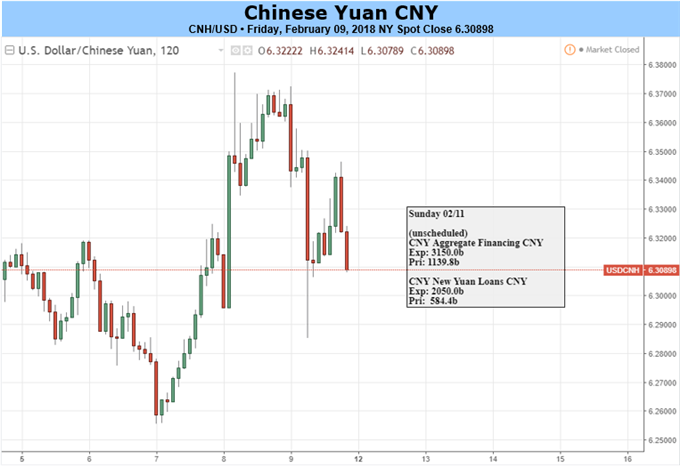
Fundamental Forecast for CNH: Neutral
- Further corrections in the Yuan are likely to be seen amid Chinese regulators’ concerns.
- Chinese retail stock investors may continue the sell-offs while the government may step in.
- China will launch Yuan-denominated oil futures and continue to crack down cryptocurrencies.
How to plan your trade wisely in a turbulent market? Read DailyFX’s Top Tips.
The Chinese Yuan had a volatile week with huge swings: the onshore CNY dipped as much as -742 pips (-1.18%) against the U.S. Dollar on Thursday and then bounced back on Friday with a range of 494 pips (0.78%); the offshore CNH lost more than -0.6% for two consecutive days on Wednesday and Thursday, and then rose +0.3% on Friday. Risk-aversion driven by sell-off in equities, China’s trade issues and overbought in the Yuan have all contributed to the large moves.
Looking forward, further corrections in the Yuan are more likely to be seen, amid Chinese regulators’ concerns, chaos in both the global and Chinese equity markets, as well as the newly introduced Yuan-denominated oil futures. On the other hand, Chinese residence trading cryptocurrencies will continue to drain amid regulators’ crackdown. Also, China is heading to a one-week holiday for the Lunar New Year (February 16th). The onshore financial markets will be closed from Thursday; yuan liquidity is expected to drop significantly around the holiday, which may amplify volatility led by market sentiment.
China’s foreign exchange rate target is to maintain the Yuan relatively stable. One-way move is less desirable. Before the Yuan lost this week, it had gained against the U.S. Dollar for eight consecutive weeks despite of a lack of fundamental supports. The counter-cyclical factor introduced by the PBOC last May was intended to counter against extreme one-way moves. At the same time, huge corrections for such one-side move may not fully meet the stability target either, especially coupled with panic mood in the equity market. On Friday, the regulator only weakened the Yuan against the Dollar by roughly half of its move on Thursday. The Chinese currency may need to correct further, but from the regulator’s point of view, it is better be gradual moves.
The U.S. stocks’ falling encountered some defence in the middle of the week; yet, for Chinese equities, losses just kept piling up from Tuesday. Shanghai Composite Index plunged -9.6% on a weekly basis, the largest loss since the failure of the circuit-break system in January 2016. The difference is that this time the panic mood was spread from the global market to China, rather than the other way around. Next week, the onshore market will be open for only three days: there is a likelihood that Chinese retails investors will continue to sell their holdings as if not they would need to wait for the market to reopen on February 22. At the same time, Chinese government may step in to stabilize the market before the Lunar New Year.
In addition to the on-going global market theme, an announcement from the Chinese securities regulator on Friday could have a longer impact to the Yuan: China will launch Yuan-denominated oil futures on March 26; also, foreign investors are allowed to trade them, a first in China’s commodities market. This aims to further promote the global use of the Chinese currency. Also, China is the second largest oil consumer and the largest oil importer. Launching Yuan-denominated oil futures could benefit local oil purchasers and increase China’s impact to the main oil benchmarks, which are denominated in the Dollar.
While Chinese regulators are opening the domestic commodities market, they have escalated clampdown on cryptocurrencies. Last September, major onshore Bitcoin platforms closed their Chinese business following the PBOC’s ban. A lot of them have moved to offshore but a majority of their customers are still Chinese. Over the past month, Offshore Bitcoin platforms, Binance, KuCoin and CoinEx, have all announced to terminate their service to users from mainland China, in order to meet the Chinese regulation. Based on the conference note from the PBOC, a top priority for the regulator this year is to continue to clean up the financial market, including unauthorized cross-border transactions.
.




